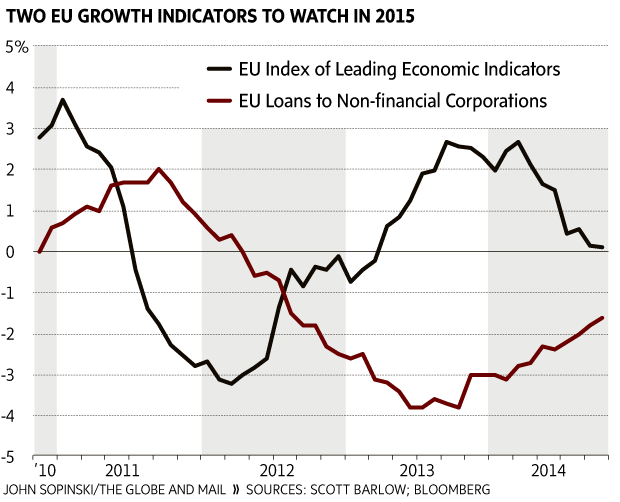When they think of Europe at all, Canadian investors view the continent as the economic equivalent of a dysfunctional family, complete with deep-seated resentments, petty squabbling, mismanaged finances and stubbornly self-destructive behaviour.
For 2015, however, the European Central Bank's efforts to stave off deflation represent the biggest risk and arguably the biggest potential source of investing opportunities for Canadians.
The European Union is, to restate the obvious, very big and very rich and a major driver of global economic activity. The gross domestic product for the EU is $18.4-trillion (U.S.), which is about $2-trillion larger than the United States and almost twice the size of China's economy. In terms of average wealth, GDP per capita in the EU was five times China's in 2013 (latest data available).
A wretched series of economic data points has seen EU economic growth estimates for 2015 slashed from an already mediocre 1.5 per cent to a truly anemic 1.1 per cent. The weaker forecast for Europe was the main driver behind the major cut in global economic optimism as the consensus forecast for world growth was slashed from 3.1 per cent to 2.8 per cent for 2015.
Europe's economic malaise comes at a time when other sources of global economic leadership are scarce. China's growth remains nominally high, at about 7 per cent, but well below previous levels. The less said about two other members of the BRIC emerging markets – Russia and Brazil – the better, as those formerly high-growth economies continue to stumble.
On Monday, in an interview with German newspaper Handelsbatt, ECB president Mario Draghi provided an official warning of region-wide deflationary pressures: "The risk [of deflation] cannot be entirely excluded … we have to act against such risk."
This statement, along with the admission that the ECB is making "technical" changes to its asset purchase program, was widely regarded as a signal of upcoming quantitative easing.
Canadian investors should be cheering Mr. Draghi's efforts to promote growth in the European Union. Slow growth in the region is clearly the biggest hurdle for global growth as the year begins and a central bank-led recovery would provide major demand support for flagging commodity prices.
This week's chart includes two indicators to gauge the effectiveness of potential ECB policies and the growth of European economies. First, Loans to Non-financial Corporations (from Eurostat), should provide the first signs of the success or failure of any ECB monetary stimulus. Like all central banks, the ECB will attempt to boost the economy through the banking channel – using quantitative easing to spur loan growth and economic expansion.
The EU Index of Leading Economic Indicators, compiled by Germany's DZ Bank, is the other useful indicator. Using measures, such as manufacturing new orders, the leading economic indicator will signal concrete proof that any loan growth is translating into tangible productive activity.
